STANLEY KUBRICK'S KILLER'S KISS
A SHOT-BY-SHOT ANALYSIS
PART ONE
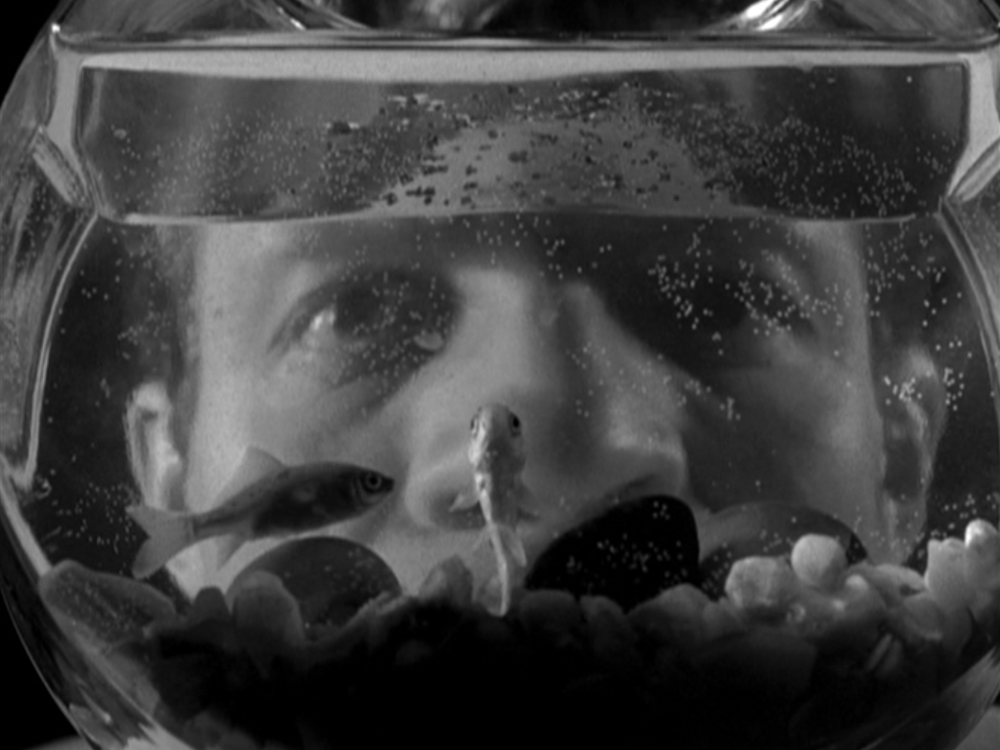
Go to TOC for this film ( (which has also a statement on purpose and manner of analysis and a disclaimer as to caveat emptor and my knowing anything authoritatively, which I do not, but I do try to not know earnestly, with some discretion, and considerable thought).
Frank Silvera - Vinnie Rapallo
Jamie Smith - Davey Gordon
Irene Kane - Gloria Price (voiced by Peggy Lobbin)
Jerry Jarrett - Albert
Ruth Sobotka - Iris
Mike Dana and Felice Orlandi - Gangsters
David Vaughan and Alec Rubin - Conventioneers
Stanley Kubrick - Story and script
Howard Sackler - uncredited script
Gerald Fried - Music
USA release date 21 September, 1955 in New York, and 1 October, 1955 elsewhere in the US.
For complete listing see IMDB.
This work followed two years after Fear and Desire, putting Kubrick at about twenty-seven years of age. Howard Sackler returned as screenwriter, though uncredited, and Gerald Fried returned for music. Frank Silvera, who had been Mac in Fear and Desire, returns. Kubrick is credited with cinematography and film editing in both these productions. Ruth Sobotka, a professional ballerina, and Kubrick had wed January 15, 1955 after several years as a couple. IMDB doesn't list set or art direction, but there are touches on the sets that are reminiscent of The Killing for which Ruth served as Art Director.
TOC and Supplemental Posts | Part 1 | Part 2 | Part 3 | Part 4 | Films Home
LINKS TO SECTIONS OF THE ANALYSIS ON THIS PAGE:
A Note Before Beginning, With a Focus on the Casting
Preparatory Viewing and reading. The influence of Day of the Fight.
Credits and Intro at the Train Station, Shots 1 through 3
Notes on the Credits. The double bass, the sweep, and the faceless man. The double bass as a pun. The train. The minotaur. 240
The Boxer and the Dancer and Their Mirrored Lives, Shots 4 through 40
Notes on The Boxer and the Dancer and their Mirrored Lives. Blur transitions. Focus upon the details. Some repeated shots from Day of the Fight. The Triad of the Hollywood Barber Shop, the Parisian Dance Hall, and Boxing, and Their Relationship to Prostitution. Day of the Fight and Twinship/doubling. Davey's mirror. The fish bowl. What about that bright shiny triangle on the wall by Davey's window? And what about that great big knife hanging by the door over what looks like a packaged Ramen leven kitchenette area? Identifying religion, as in Day of the Fight. The suggestion of a rear screen projection or blue screen behind Albert, the manager, which turns out not to be.
Location of the Apartment Building
The Letter, Shots 42 through 46.
Notes on The Letter. The letter Davey reads different from what we hear in the voice-over.
The Duress of the Boxer in his Ring and the Hired Dancer Compared and Found Equivalent, Shots 47 through 131
Notes on The Duress of the Boxer in his Ring and the Hired Dancer Compared and Found Equivalent. Santa and the swimming baby. Christmas. Shot 64 and its relationship to Day of the Fight. Trouble in Pleasure Land. Vincent's office and its posters from the theatrical productions, Blue Jeans, and The Cherry Pickers. The fight. Who is the audience. How many times have you come home in the evening and wanted to feel the love... It's a well known ring adage that too much education... Shot 114.
The Situation
When I first saw it, I'd little use for Killer's Kiss, however much I was appreciative of its essential relationship to Kubrick's later work. The music was (still is) mostly intolerable, the acting by the two leads was problematic, and the melodrama stood a firm third in the negative line that obscured vision of the positive waving at me from the background, "See me, like me?" So I was surprised, as I went through the film shot by shot, how my attitude about it began to shift. Killer's Kiss still speaks more to what Kubrick learned not to do in a film, just as with Fear and Desire, but I warmed up to Davey, the down-and-out boxer, his plight, the emotional rationale of his falling for Gloria, and even their stiffness, as long as I looked upon them as being kind-of-awkward Gloria and Davey who found each other in the big city which has something for everyone--and as long as I did my best to ignore the music score, exempting the wonderful warehouse and city streets sound scapes toward the end.
That I learned to not squirm over such things as Gloria's clumsy run through Penn Station into Davey's arms, instead interpreting her lack of grace as a primary component of her character, makes me wonder if there's not an element of Stockholm Syndrome at work and that due my captive immersion while seeing this project through I've become fond of eccentricities, and a lack of aesthetic agility, that should, in fact, be irritating.
But maybe that's the point, that Gloria is inescapably a confusing lack of any and every quality which even indie films determine make leading women attractive, just as Shelley Duvall's Wendy in The Shining irritates so many. Star quality causes the the planets to gravitate in happy, hypnotic unison, and reveals Warhol's supposed improvisations at The Factory for the Hollywood bastardizations they were, the camera captivated by beautiful people rather than lonely asteroids. This isn't casting aspersions on the actors Jamie Smith or Irene Kane (who would go also by Irene Greengard, Helen Kane, Chris Kane, Chris Chase) and pronouncing either as being cognate with the characters they played and that they weren't actually acting. Instead, the characters they gave us may very well have been what Kubrick wanted, or believed that he did, whether for a moment or the duration. No matter what the ads for Killer's Kiss said, falling in line with and feeding the expectations of the 50s, Gloria isn't meant to be a sultry, confident femme fatale or else she wouldn't cling so pathetically to her childhood doll, and Davey is no suave, charismatic Hollywood leading man magnetically wooing the female audience into his cinematic arms. Just as with Lolita, only when the advertising is comprehended as an intentionally false front, a mask, and only when we wholly abandon what Hollywood has trained us to expect, can the characters find their rightful place. Even if we understand film artistically and scorn Hollywood, Kubrick's place in big cinema, and his advertising history, as well as the remarks he made to the media on his films, can deceptively lead one to expect something other of his characters than what one gets, and is a cause for cognitive dissonance.
Unhappy Gloria descends steps, on her way to work, with a meandering lassitude that testifies less to unwillingness than a reluctance to critically review what she's doing and where she's going. Insecure and haunted Gloria walks with bowed shoulders, her purse clutched to her chest. Timid Gloria reacts with fearful but curious uncertainty when her boss begins to beat up a soldier dancing with her. A teasing Gloria not so very intelligently goads her sadistic boss' jealousy over her new paramour when she goes to his office to pick up her check. A not-very-bright Gloria returns to get that check after being threatened and thrown out of the office, but she also needs that money. Aimless Gloria, walking in the shadow of her talented family, is bereft of any purpose. Orphaned Gloria, her affection for her father unrequited, sleepwalks as one imprisoned by her familial nightmare and unconscious of the dream that imprisons her.
What we see may very well be what we were supposed to get, characters that played to type in advertisements but grated against those types on celluloid. Always, with the character and supporting actors, there is never any dissonance, they are what they are, what the audience expects from their assigned roles, but not so with the leads. We had much the same disaffection of the public with Ryan O'Neal in Barry Lyndon, Tom Cruise in Eyes Wide Shut, and even, to some extent, Keir Dullea in 2001, these films occupying prominent spaces in film history not only despite this but perhaps even because of certain perceived weaknesses of some actors in their roles being, rather than a deficit, a planned disconnect that opened up for the audience intimate perspectives which wouldn't have been had otherwise. Dullea had nothing of the heroic leading man charging the screen with chiselled jaw, connect-the-dots emotion and never-say-die bravado, and yet his largely blank face is the perfect counterpart to HAL and enables the audience to occupy his ride. Shelley was not the standard heroic, sexy leading woman, but her bewilderment and lack of assurance are strategic and key points of empathetic access to the film. Tom Cruise as well goes against the leading man type, his introverted wandering of the set's streets of New York recalling Gloria.
Of course I could be talking a lot of BS, I'm just reflecting on how the films were received when they first came out and on different leads who were initially deemed as weak.
Irene didn't even voice Gloria's character.
As for the choice of Jamie Smith, as Gordon, I do wonder if his having worked with Orson Welles played a role in his being cast, which I explore in Kubrick's References in Killer's Kiss to an Obscure Magic Film by Orson Welles..
Despite my druthers, examining the film shot by shot, I have been ultimately won over by Gloria and Davey. As I've said, I have no idea if this is Stockholm Syndrome.
With this film, Kubrick returns to what he knows, the subject of boxing, which he had previously explored. I would suggest, before getting into Killer's Kiss, watching Kubrick's first film short Day of the Fight and reading my analysis on it. It's not enough to know that Day of the Fight is also about a boxer--among other things, that film will introduce one to Kubrick's already emerging interest in doubles, the boxer preparing for the fight with his twin and their identities merging at times. My analysis discusses certain themes in that film that also re-emerge in Killer's Kiss. Then, in the supplemental section I would suggest reading the several posts on Rosemary Williams. Kubrick had first done a LOOK article on Walter Cartier before making the boxing film on him. He had also done photos for a LOOK article on Rosemary Williams, which never saw print. One can see how Kubrick was likely hoping to represent Rosemary, a showgirl who hoped to become an actress, as a feminine counterpart to Walter Cartier. He pictured both at home. He pictured them both at church (surprisingly, both Roman Catholic, just as Davey is Roman Catholic). He showed them in relaxed social situations, in training for their professions and each on their respective professional stages. Walter was the up-and-coming boxer. Rosemary was the up-and-coming show girl. Might they become wild break-out successes? Walter, though I read he was a great boxer, and had Irving Cohen as one of his managers, who also managed Rocky Graziano, never became a champion, but he did have a solid career in boxing for a while. He later had a few small acting roles. As for Rosemary, her career crashed and burned when, right about the time Kubrick was photographing her, she became involved with a conman and accepted thousands upon thousands of dollars worth of gifts from him. Reading between the lines in the little I can find on the case, she was not viewed as entirely innocent. I don't know whether or not she was a good actress, but she had been a popular photographer's model. Jobs dried up. Her career apparently foundered.
Rosemary was not just photographic, she had a certain charisma that activates celluloid, so she brought sometimes a motion picture sensibility to Kubrick's photos of her. In this analysis I point out certain photos of her, as with Walter Cartier, that appear to have had an influence on or have been duplicated in Killer's Kiss
Rosemary and Walter were training ground for Killer's Kiss and it's worth checking out Kubrick's earlier work on them.
Killer's Kiss was released October 1 1955
1 Black screen with the sound of the train. Fade in to "A Minotaur Production" over a LS scene at Penn Station. (00:27)
A man passes right carrying an acoustic bass. Though we don't know who he is yet, Davey, the male protagonist, stands centrally near a bag on the ground. He paces back and forth.
The credits quickly fade in and out.
KILLER'S KISS
Starring FRANK SILVERA
Station Announcer (voice-over): The Silver Arrow, for (?) and Chicago...
With JAMIE SMITH and IRENE KANE
Station Announcer (voice-over): Leaving at one o'clock...
JERRY JARRET, MIDE DANA, FELICE ORLANDI, SHAUN O'BRIEN, BARBARA BRAND
Station Announcer (voice-over): ...track two...
Davey lights a cigarette.
Station Announcer (voice-over): ...for Philadelphia...Pittsburgh...
DAVID VAUGHAN, ALEC RUBIN, RALPH ROBERTS, PHIL STEVENSON, ARTHUR FELDMAN, BILL FUNARO, SKIPPY ADELMAN
Production Manager: Ira Marvin. Camera Operators: Jesse Paley and Max Glenn. Chief Electrician: Dave Golden. Sound Recordists: Walter Ruckersberg, Clifford Van Praag. Assistant Editors: Pat Jaffe and Anthony Bezich. Assistant Director: Ernest Nukanen. All characters in this picture are fictitious etc. Sound by Titra Sound Sudio.
Love Theme from the Song "ONCE" by NORMAN GIMBEL and ARDEN CLAR
A bell begins clanging. It will ring about 20 or 21 times through the following credits.
Ballet Sequence Danced by RUTH SOBOTKA. Choreography by DAVID VAUGHAN
In the screen's right, the bass player we had earlier seen reappears in the distance, beginning his trek back.
Davey drops and crushes out his cigarette with his foot.
Story by STANLEY KUBRICK
Music Composed and Conducted by GERALD FRIED
The bell that had begun ringing earlier has faded then is drowned out by the sound of the train engine chugging.
Produced by STANLEY KUBRICK AND MORRIS BOUSEL
A sweeper has entered on the right, coordinated with his appearing at about the same distance now as the man with the bass, but the man with the bass outpaces him as he heads toward forefront screen left to exit.
The bass player exits left as the following credit appears.
Edited, Photographed and Directed by STANLEY KUBRICK
The sweeper exits left as well. Davey has lit another cigarette. Just before shot 2, a man has crossed to screen right in the medium background and looks toward Davey or the camera, his face in deep shadow.
2 MS Davey. (1:50)
DAVEY (voice-over): It's crazy how you can get yourself in a mess sometimes and not even be able to think about it with any sense. And yet not be able to think about anything else.
The camera pans with Davey as he walks so we briefly see the station's clock and that it reads about 2:40.
DAVEY (voice-over): You get so you're not good for anything or anybody. Maybe it begins by taking life too serious. Anyway, I think that's the way it began for me. Just before my fight with Rodriguez, three days ago.
The screen begins to blur as we transition to shot 3.

3 Blur Transition to image of Davey. (2:20)
Music begins.

The bass player is the most Kubrickian element of this section. Here's a scene that by all rights should just be a milling crowd. Kubrick saddles a man with a bass which makes him stand out just enough, but as he's also at the far right of the screen you don't notice him because the focus is on Davey, but (yes, another but) if one's attention is acute one will realize the bass player reappearing, retraversing the stage fully and exiting left. This is scripted and with no obvious reason. It's a recycling and Kubrick is fond of circularities, or rather spirals of action. He began and ended Fear and Desire with what seem exact same shots but the tonality is different. He will do the same with Lolita, begin and end with Humbert at Quilty's mansion but they aren't the same take, there are subtle differences. The bass player seems another expression of this. The sweeper is timed to coordinate with him and then at the end of the scene we have the man who has crossed to the right in the background and looks toward Davey and/or the camera, his face in such dark shadow that he almost appears masked, as if he has no face. With that addition it becomes a foreboding montage of individuals that seems to look back at us from violin-case-toting, fedora-and-mask-wearing Sterling Hayden's future in Kubrick's next film, The Killing, Hayden's cash loot spread all over the airport tarmac ready for a sweeping. We've also a connection with the opening of The Killing and Marvin Unger walking the expansive set of the race track clubhouse, a man sweeping up tickets and other trash in the background.
The double bass, which we are supposed to eventually notice, crossing the screen twice, seems actually a visual pun, intended to refer to Kubrick's interest in doublings. Kubrick chose to open Day of the Fight, the Bonafield version which required an appended introduction, with a doubling. We see in shot 1 TONITE BOXIN on an exterior marquee, then the second shot shows a printed sign that reads BOXING TONIGHT.
In all of Kubrick's later work, when you see anything referencing a train, Kubrick overtly includes deja vu references. In A Clockwork Orange, a comic book has the story of a photographer marvelling over his witness of a train running into a phantom buggy, an event that occurred decades in the past but somehow he was able to see and relive it. Accompanying text reads, as to the camera, "What amazing power did it have which allowed it to photograph the long dead past? Find out in 'The Strange Old Camera!'" In Eyes Wide Shut, Bill's "Lucky to be Alive" newspaper has in it a story of a hostage situation on the train which recalls a hostage situation on the train in an earlier year, almost to the day, and makes mention of the trauma of reliving events again and again. This is Kubrick's first use of the train and we will later hear train whistles when Gloria is being held hostage. In my other analyses I associate this thematic use of the train with Kubrick's possible interest in ZKR.
I've received a lot of flack for suggesting that The Shining has within it a minotaur theme to accompany the maze, even though the ancient minotaur's home was the labyrinth built especially to contain the half-man, half-bull, even though a labyrinth was only metaphorically mentioned once in King's book and the maze was a distinctly Kubrickian addition, even though Jack descends into an animalistic state of incoherence over the course of the movie and Danny defeats Jack through his entrapment in the maze. Which speaks directly to the Minotaur's inability to transcend the twists and turns of his prison.
Modern bullfighting isn't associated with the ancient labyrinth story, but has come to be, and the car Scatman drove in The Shining was a Matador.
Kubrick left behind a quote that links a certain type of storytelling with bullfighting.
"In a crime film, it is almost like a bullfight; it has a ritual and a pattern which lays down that the criminal is not going to make it, so that, while you can suspend your knowledge of this for a while, sitting way back in your mind this little awareness knows and prepares you for the fact that he is not going to succeed. That type of ending is easier to accept."
A convenient crime film template is not the all-in-all of Kubrick's use of the minotaur myth, for his stories are played out in labyrinths and mazes in nearly every one of his films, done so in a carefully scripted fashion supplying a fundamental organization of labrys mirrorings that are confounding to those viewers who become aware they are, with the characters, walking avenues, sometimes not even barely disguised, down which they've already traveled. All of this for more easily accepted finales makes for a specious purpose when the audience is rarely cognizant of the labyrinth in the first place, and when they do become aware of the maze (such as in Eyes Wide Shut) can often only think to explain away the ritual and pattern of the maze as a lazy reluctance to change a few neon lights with the money-saving reuse of a set, and add intentionals to the goof list on IMDB. Kubrick using two actors to play two roles in Fear and Desire has been stated to be for sake of economizing, but as I show in the Fear and Desire analysis, Kubrick himself did write about this and how it was an intentional confrontation with one's double. The film was released in 1953, and in 1952 Kubrick wrote, "Its structure: allegorical. Its conception: poetic. A drama of 'man' lost in a hostile world--deprived of material and spiritual foundation--seeking his way to an understanding of himself, and of life around him. He is further imperiled on his Odyssey by an unseen deadly enemy that surrounds him; but an enemy who, upon scrutiny, seems to be almost shaped from the same mold."
I would say the labyrinth in A Killer's Kiss will later be the empty, dead-end streets of the city, but the labrys is at work from the beginning.
Kubrick likes the number 24/42 and uses it a lot in his films. It appears here at the beginning on the clock in the form of 2:40. 24 will also enter the film again in shot 334 when Vincent reveals that Gloria is being held captive in a warehouse on 24th street. When Gloria is seen walking New York after leaving the Pleasure Land dance hall the first night, according to an old article on the film she is apparently on 42nd street. The story is that someone in a truck kept blocking Irene until she promised to go out with him.
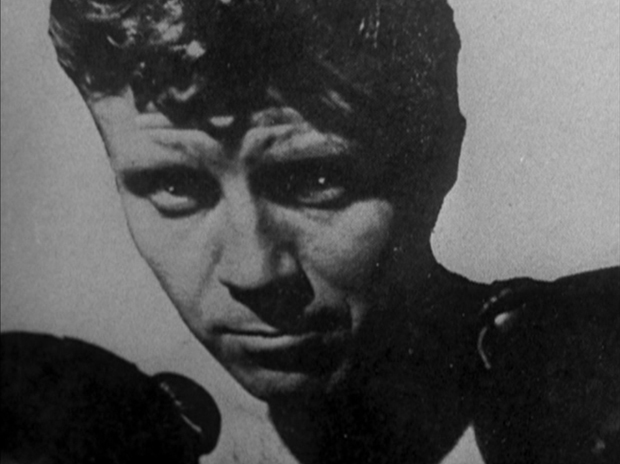
4 Poster of Davey. (2:23)
The poster reads "A Slugging Welterweight Natural. City Arena - Fri. Oct. 25. 10 Round Main Event. Davey GORDON, Kid RODRIGUEZ. Other Great Bout. Admission $1;50. Reserved 3:00.
The music which I'll call "Davey's theme" plays. Aggressive, strident, plodding, horns.
5 Same poster of Davey in a pool of water on the ground. A man passes before us stepping on it. (2:26)
6 Same poster of Davey tacked on a pole, bending with the wind. (2:29)
7 Same poster of Davey in the window of Hollywood 867 Barber Shop. (2:31)
Beside it is a small sign reading "Storage for Davy Carraci".
8 Closer view of same poster of Davey. (2:33)
Begin crossfade to shot 9 of Davey looking at himself in a mirror, so that we briefly have Davey in the poster staring over his own shoulder.
Shot 4 | Shot 5 |
 |  |
Shot 6 | Shot 7 |
 |  |
Shot 8 | Shot 8a |
 |  |
9 MS Davey in a mirror in his apartment. (2:36)
He examines his face, rubbing his right hand above his right eye, pressing up and down on his brow as he purses it.
10 CU of a photo of a large building in the country, perhaps a barn. (2:45)
11 CU of a photo of a woman standing by a porch, and two customer laundry tickets. (2:47)
The tickets are 04360 and 04359 for WASHLAND, half hour laundry service, 659 9th Avenue NYC.
12 CU of a photo of 2 cows. (2:49)
13 CU of a photo of a man and a black and white dog. (2:52)
14 MS of Davey before his mirror. (2:54)
He runs his finger down his nose. Then he stops and knots his fingers together, scowling into the mirror, belying perhaps the confidence of his poster.
This is a shot that Kubrick has duplicated from his first film Day of A Fight, just as several poster views are taken from Day of the Fight.
Shot 9 | Shot 10 |
 |  |
Shot 11 | Shot 12 |
 |  |
Shot 13 | Shot 14 |
 |  |
Kubrick often has photos in his films but rarely if ever again will he focus in on these incidentals as he does here. In later films they form the fabric of the background.
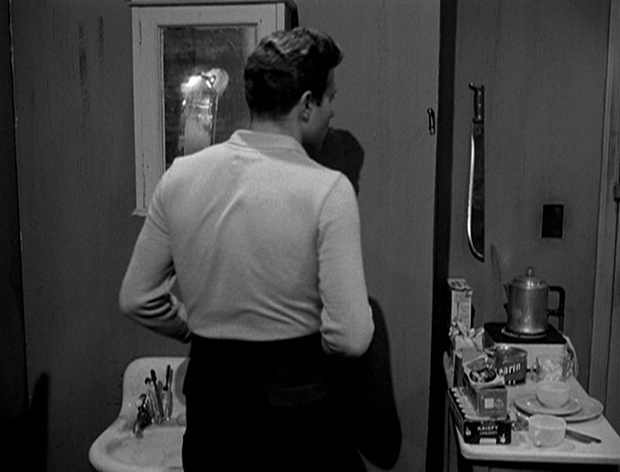
Davey turns and walks to screen right to a sink, above which is another mirror. He takes a cup from a counter, runs water in it, drinks it, replaces the cup. He now goes again to screen right, the camera traveling with him, to stand before his table and wipe his hands on a towel. We get our first glimpse of his neighbor in the apartment across through the window.
Davey then turns right again and walks over to his goldfish bowl, Kubrick having taken us in a 270 degree circuit of the room.
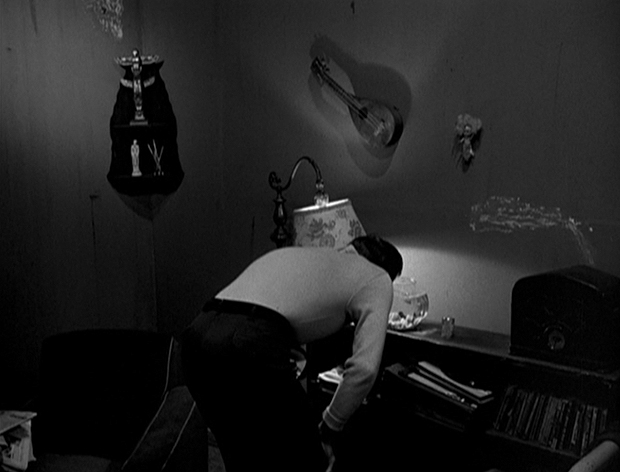
15 CU of Davey's face through the goldfish bowl. (3:53)
16 MLS of Davey turning, going back to the window and glancing out it at his neighbor. (3:59)
He swivels and checks out his hair in the mirror again, then goes to his bed and lies down.
17 CU of the bedside clock which reads 6:50. (4:21)
Again, Kubrick is showing close-ups of details that he rarely ever does again in his films.
18 MS from beyond the 4th wall of Davey lying down on his bed. (4:23)
The phone rings and he answers it. There is no music during this period.
DAVEY: Hello.
19 MS Davey's manager at the gym. (4:27)
ALBERT: Hello, Davey.
DAVEY: What's keepin' ya...
ALBERT: How are ya?
DAVEY: ...I hate to wait around like this. It makes me nervous.
ALBERT: You better hop a cab. I had some trouble with the car and it's still tied up at the shop. I'll meet ya over at the arena.
DAVEY: Okay.
ALBERT: Right.
He hangs up the phone and turns to the rear, and it's one of the stranger shots in film history. The difference between the foreground and background in lighting and perspective suggests this is a rear screen projection he's before. As he hangs up the phone the camera pans right to show the wall. Then he turns to walk to the rear and it seems for a moment as if, no, it must not be rear screen. One examines it and thinks maybe where the white wall at the right ends shows us where the rear screen begins?
It is actually not a rear screen projection as we shall see in a later shot. But Kubrick certainly staged this to make it look like a rear screen effect.
Shot 15 | Shot 16 |
 |  |
Shot 17 | Shot 18 |
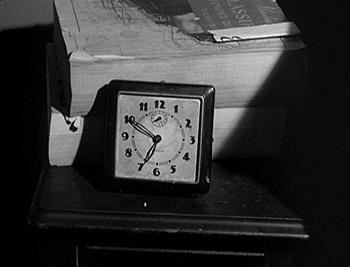 |  |
Shot 19 | Shot 19a |
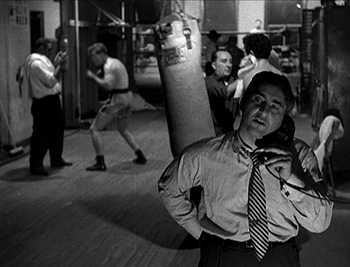 |  |
20 MS of Gloria in her apartment. (4:45)
The manager having turned his back, Kubrick now cuts to Gloria with her back to the camera.
For music we have what I'll call "Gloria's theme", which is syrupy strings.
The music changes from strident and noir to sentimental.
Gloria advances to her table and takes a sip from a coffee cup. We see her clock reads 6:50. She turns, advances to her window and looks out it across the way.
21 MCU of Gloria from outside her window, she staring over at the boxer. (4:54)
22 LS the boxer through Gloria's window. (4:56)
23 MCU of Gloria from outside her window, she staring over at the boxer. (4:59)
24 LS the boxer through Gloria's window. (5:13)
25 MCU of Gloria from outside her window, she staring over at the boxer. (5:14)
26 MLS of Gloria inside her apartment, finishing her coffee. (5:17)
She gets her coat from her closet.
With 21 through 25 we have our first real dialogue sequence of shots.
Shot 21 | Shot 22 |
 |  |
Shot 23 | Shot 24 |
 |  |
Shot 25 | Shot 26 |
 |  |
Below is from shot 26, as Gloria moves to get her purse, having taken her coat from the closet.

27 MLS of Davey exiting from screen left out his apartment. (5:35)
Just as Kubrick had cut from the Manager's turned back to Gloria's, now, with Gloria having moved from screen left to screen right, Kubrick continues the right moving energy here so we almost expect to see instead Gloria exiting her apartment even though we've seen the door to Nancy's apartment behind her, but she has reached out for her purse in such a way that Davey's exiting the door with his hand on the knob is a sensible continuation.
28 MS of Gloria. Taking her purse she goes to the door of her apartment and cuts off the light. The screen goes black. He goes down a flight of stairs. (5:40)
29 MLS of Davey on a landing, emerging from a dark shadow. (5:44)
30 MLS of Gloria on a landing, turning and continuing down a twin flight of stairs. (5:54)
31 MS of Davey on a landing, turning and going down the stairs. (6:06)
32 MLS of Gloria going down a flight of stairs. (6:11)
Shot 27 | Shot 28 |
 |  |
Shot 29 | Shot 30 |
 |  |
Shot 31 | Shot 32 |
 |  |
33 MS of a row of mailboxes in the apt hallway. (6:14)
Davey opens one with a key and takes a letter from it, closes it then turns and continues toward the camera.
34 LS of the exterior of the apartment building. (6:22)
Gloria languidly emerges from her door opposite as Davey emerges from his. They glance at each other, nod, and continue screen right.
35 LS of Gloria's boss waiting for her in his car. (6:32)
Gloria and Davey emerge from the apartment building at the same time, walking away from the camera. Gloria's boss gets out of the car to round it and open the door for her.
36 MS of Vincent Rapallo rounding the car. (6:41)
He looks at Davey as he passes right.
37 MS of Davey entering the 8th Ave Concourse. Downtown to Fulton St., Brooklyn, Queens. (6:44)
Davey glances back as he goes down the stairs.
38 LS of Gloria seated in the car and Vincent rounding to the driver's side. (6:50)
39 MCU of Vincent from Gloria's right. (6:56)
VINCENT (climbing in the car and closing the door): You're doing all right for yourself.
GLORIA: What do you mean?
Vincent nods in the direction of the subway entrance.
GLORIA: Oh, he just lives in the building.
VINCENT: Oh. Used to be a pretty good fighter.
GLORIA: Fighter?
VINCENT (starting the car): Sure. He's fighting tonight as a matter of fact. We can watch him on the TV.
40 LS of the car pulling away from the curb and turning left. (7:13)
Shot 33 | Shot 34 |
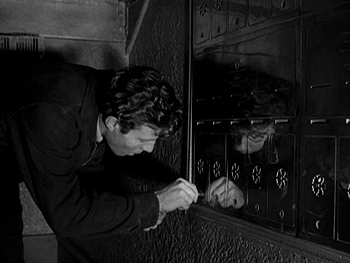 |  |
Shot 35 | Shot 36 |
 |  |
Shot 37 | Shot 38 |
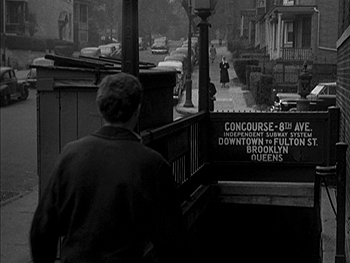 |  |
Shot 39 | Shot 40 |
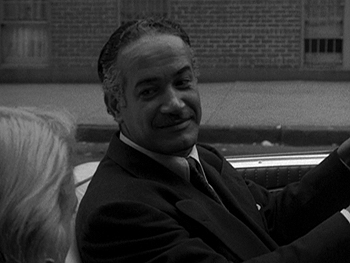 |  |
If you like the blue transitions, enjoy them here because I don't recollect Kubrick ever using them again. He instead later used crossfades.
Kubrick shows us a lot of details in this film. He didn't in Fear and Desire because that was a film in a natural setting, a forest. Kubrick's type of filmmaking depends strongly on the set for communicating story information, symbolism and metaphors, and I personally think for that reason, after Fear and Desire, Kubrick never did again film with a forest as primary set. Plus, it's damn hard to get interesting cinematography in a forest for the duration of a film. One needs quite a different storytelling technique from Kubrick's.
What's interesting is that Kubrick, now that he's working in the city as opposed to the forest, labors to show the audience the details in the background. This is something he will never do again. He learns along the way to keep the details background, which doesn't mean one isn't supposed to notice them. One is. But Kubrick leaves it up to the audience to stay alert to them as a background component of the storytelling, rather than handing them on a silver plate to the audience.
Kubrick, in this section, duplicates boxing poster shots from Day of The Fight. He also duplicates shot 33 from Day of The Fight of Walter Cartier examining his face in his mirror.
In Day of the Fight, the boxer, Walter, had a twin named Vincent, and the mirror play has everything to do with this twinship.
We see one of the boxing posters in the window of a Hollywood Barber Shop marked with the street number 867. A Manhattan telephone directory for 1940 (the closest date I have available to me, and I reason that barbers are a long term business) shows one Hollywood Barber Shop at 1570 Broadway, but which is no longer there in 1955. 1570 Broadway is Times Square territory where we spend some time in this film as the dance hall is located there. Indeed, the Parisian Dance Hall, which is used as an exterior for Pleasure Land, where Gloria works, was located at 1568 Broadway. Shot 6 shows a view of Broadway in which we see, beyond a boxing poster stuck on a pole, the huge Pepsi Cola sign that was synonymous with Times Square and opposite it the Mayfair Theater which was just a couple doors down and across W. 47th Street from the Parisian Dance Hall. The Parisian Dance Hall, by the 1950s, had as its screen left neighbor a drugstore, and on screen right was the RKO Palace at 1564 Broadway. Shot 7 shows us the exterior of the Hollywood Barber Shop now at "867", which is across from a laundromat (we see its sign in the window). This must be the barber shop earlier located next the Parisian. Going from the corner where it was once located, to 867 in the next shot, Kubrick is clearly drawing a relationship between the barber shop and the Parisian Dance Hall next which the Hollywood Barber Shop was once located. In the window he has a poster for the boxing match. Why make this triad?
Kubrick may be making this association because barber shops were once associated with prostitution, in the 18th century "barber's chair" was slang for a prostitute, and in other parts of the world the barber's pole may still signify a place of prostitution.
From the book Masculinity and the Metropolis of Vice, 1550–1650:
...barbers would have been a visible presence in every parish, while their congregating in areas particularly notorious for prostitution and other vices suggest that some of these barbers either trafficked in or otherwise profited from illicit and immoral activities that capitalized on masculine vice...
Surely a number of barbershops must have been operating as brothels, or a number of barbers were allowing prostitutes to conduct business on their premises, in order for inspections to become necessary...
In the literature and drama of the period, the early modern barbershop and its appurtenances function (often proverbially) as metaphors for prostitution: the barber's glass or mirror, cittern or lute (or any other musical instrument kept in the shop), because common to all men, are comparable to whores The barber's warming pan or chafing dish could function as metaphors for female pudenda; and, as the title of the anonymous ballad "The buxom wife that went a maying a brisk barber for his long pole" suggests, the barber's pole or razor could also operate figuratively and explain the barber's imagined proclivity for turning the women associated with him or his shop into masculine, diseased, and/or lascivious whores...Since antiquity, baths had been associated with brothels, and both sites--the areas in which they were located and the bodies made available in them--were commonly referred to as stewes...
...the early modern suspicion that barbers may be panders and barbershops bawdy houses can inform our reading of early modern drama in which barbers and their shops are featured or alluded to. How, for example, might the knowledge that many barbershops and their immediate environs functioned as stews influence our reading of Ben Jonson's Epicoene, or the Silent Woman...
Just as Kubrick makes Gloria, the taxi-dancer, a counterpart of the boxer, and illustrates by cutting between the boxing rig and the dance hall the harsh similarities of their professions, George Bernard Shaw also compared boxing to prostitution. From Kasia Boddy's Boxing, A Cultural History:
As work of last resort, Shaw further maintained, boxing had much in common with prostitution...'As long as society is so organized that the destitute athlete and the destitute beauty are forced to choose between underpaid drudgery as industrial producers, and comparative self-respect, plenty, and popularity as prize-fighters and mercenary brides, licit or illicit, it is idle to affect virtuous indignation at their expense.'
Further, Kubrick will make an association between Gloria's older sister, Iris, and prostitution, due her marrying a man she didn't love in order to take care of her dying father and her younger sister. It is apropos then that she would commit suicide by slicing her wrists, presumably with a razor.
Kubrick's Day of The Fight was a documenatry of a boxer, Walter Cartier, who had a twin, Vincent, who was also a boxer, but was by then a lawyer and seemed to have largely given up boxing except to help Walter with his training. Kubrick gets rid of the twin in this story, but not the doubling.
As already pointed out, he begins with the double bass crossing the screen twice at Penn Station. A sort of doubling is had with the storage sign for a Davy Carraci, next the sign for Davey Gordon, in the barber shop window. We then go to Davey's apartment where he is examining himself in the mirror. Doubling. What we will eventually find is that Gloria is intended to be a feminine double of Davey's, and a feminine double to Walter Cartier is already hinted at in Day of the Fight, at the end, when Walter Cartier is being garbed in his robe in shot 97, then in shot 98 there is commentary on "This is a fighter" as we see a man draping a white coat over a woman's shoulders. There is no reason for that shot to be there if not to bring in a female aspect to the doubling. I have written on this in my analysis of Day of the Fight, and have in posts on Rosemary Williams, the showgirl Kubrick photographed, explored in depth how she was intended to be Walter's counterpart, a version of this finding its way into this movie with Gloria. I believe she even, discreetly, appears in the film Day of the Fight in the audience.
The fight poster, simply by virtue of the usual layout of these signs, takes the names of two individuals and presents them in such a way that we almost read them as one individual, such as Davey Gordon and Kid Rodriguez transforming into Gordon Rodriguez.
The layout of the two apartments functions as twins, a labrys or double-headed axe where one side mirrors the other, and does so here with the mirrors of Davey and Gloria facing one another through the windows, which also implants Gloria in Davey's apartment and Davey in Gloria's apartment by means of their reflections. Though they've only known each other for two days, according to the movie, by virtue of these mirrorings they are intrinsically bound together, complementary male/female halves of a Platonic whole.
The apartments mirror each other but are different in their details. When the characters step into the hallway those personal details vanish and we find that Davey's and Gloria's doors and hallways are exact duplicates, because Kubrick used the same hall and door for them. But that isn't for simple convenience. Shots 29 through 32 and 299 through 303 are explicit in showing us that those halls and doors are exactly the same. Which, if you think about it, should not be. As Gloria and Davey have apartments facing each other, their halls and doors should be mirror images, as their rooms are mirror images, rather than the same. I'll gladly accept the hall/stairwell being the same for both apartments as a matter of convenience, but one also has the feeling of Kubrick making intentional use of this, especially so in shots 300 to 303.
Davey and Gloria leaving the building, Vincent enters the picture, Gloria's boss, the name reminding us of Vincent as twin to the boxer, Walter, in Day of the Fight. This Vincent will turn out to have more to do with Gloria's father but as this film borrows from Day of the Fight in other ways then the fact that we have a Vincent in both films should perhaps not be ignored.
Davey's mirror serves to collect photographs of, likely, scenes to do with his rural relatives in Washington state. A great, atmospheric picture of cows is seen among these things. There's a barn. A farm or at least a place with livestock is referenced.
There are also items from Davey's daily life in New York. We see two tickets for Washland, a half hour launderette at 639 9th Ave. in NY, that seems to read as being between 44th and 45th street. If you look up 639 9th Ave. in the current day you get also 400 West 45th Street as a seeming dual address for housing up above. An old listing I found for 639 9th Ave. was for Cheryl TV Corporation in a 1955 issue of Billboard. They were handling 3 features, "Battles of Chief Pontiac, "Run for the Hills", and "Hannah Lee". Another address for Cheryl TV was in Hollywood. A 1930 issue of Film Daily has at 639 9th Ave. the Film Delivery Association. Anyway, it's perhaps of interest that on the mirror are these two tickets for Washland, one punched, and in the apartment opposite is Gloria who dances at Pleasureland.
Can't let the fish bowl go without mention, because out of this section Davey gazing through the goldfish bowl opposite the camera is obviously the shot Kubrick expected everyone to talk about. Davey in the fishbowl. In that respect, it's the eye candy, and would make everyone think of Gloria and Davey living as in an urban fishbowl in their small rooms looking directly on each other. We should also compare the fish in the bowl to the later television screen on which Vincent and Gloria watch Davey lose his fight.
It's the Illuminati Goodhousekeeping Stamp of Approval! I don't know. Your guess is as good as mine. I do note its presence as it stands out and so is a curiosity.
You mean that overzealous butcher knife that's longer than the counter is wide? It's kind of deliberately scarey, that's what it is.
If you consult Part 4 of the analysis you'll see it's likely an homage to "The Girl Hunt Ballet" in The Band Wagon, the fight in the mannequin factory supposedly having taken inspiration from the brief mannequin scene in the Astaire film. Prominently displayed in the mannequin section of that film, we observe a butcher knife standing high on its blade, the tip stuck into a counter between the head of a mannequin disconnected from its body.
Like Walter Cartier in Day of the Fight, we can guess from the presence of a Madonna statuette that Davey is likely a Roman Catholic. Presiding over this however is the crucifix-like statuette of a "totem pole" that signals a connection with the pacific northwest.
I explore this at length in Kubrick's References in Killer's Kiss to an Obscure Magic Film by Orson Welles.
Found it!! The apartment building that Davey and Gloria live in? It’s still standing. The building is the Perry Arms, at 3156 Perry Ave. in the Bronx, cornering 205th. Not only is the 1925 building still standing but it even has the planters out front. And the rooftop is clearly the one Davey runs around on from his side of the building to Gloria's.
In the Google screenshots below, we see the entrance where Vincent picks up Gloria and the subway entrance Davey uses.
Since my locating the building, it has since been placed on IMDB. I don't know if that is from my find or someone else's. How I located the building was via the subway that Davey uses, hoping on the off chance that it was indeed right there at the building that was depicted as home, and hoping also of course that if that had been the case the building hadn't since been torn down. The film shows the subway entrance reading "Concourse - 8th Ave, Independent Subway System, Downtown to Fulton St. Brooklyn Queens." This was no help at all to me in locating the station, which in Google we see as the "205 Street Station". I had to look and look and look, not being familiar with the New York subway system, and finally came upon the right one.
41 MS of Davey on the subway. (7:16)
Davey takes out the letter he'd received and removes it from the envelope.
Music plays that is supposed to remind us of the comforts of country home.
42 MS of the letter. (7:24)
GEORGE (voice-over): Dear Davey, still haven't heard from you yet this...
43 MCU of Davey in profile. (7:29)
GEORGE (voice-over): ...month and we wondered if everything was still all right with you. Out here everything's about...
In this shot there's a brief black-out on the words "was still".
44 MS of the letter. (7:35)
GEORGE (voice-over): ...the same.
45 MCU of Davey from below. (7:37)
GEORGE (voice-over): I still get into Seattle every week and the ranch has prospered nicely. Last week I finally bought Mr. Henderson's chestnut Arabian stallion. Your aunt...
46 MS of Davey from the front. (7:47)
GEORGE (voice-over): ...Grace's arthritis is much better. She can even take short rides on Jumper now and then. Well, I guess that's all now except that we miss you alot, Davey. Write soon. Love, Uncle George and Aunt Grace.
As Davey finishes reading, he smiles and looks encouraged.
Shot 41 | Shot 42 |
 | 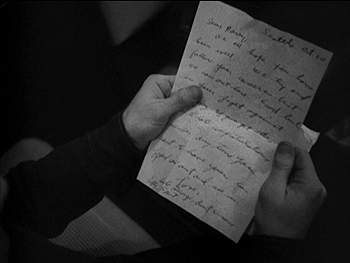 |
Shot 43 | Shot 44 |
 |  |
Shot 45 | Shot 46 |
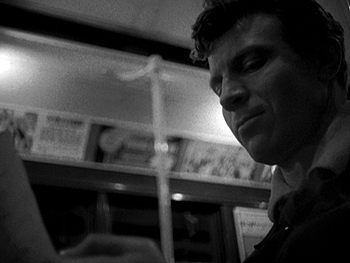 |  |
The letter we see on screen is different from what we hear in the voice-over.
Seattle, Oct 20. Dear Davey. We all hope you have been well. We try and follow your career best we can out here. Good luck on your fight against Rodriguez. If you get the (illegible to me) late congratulations. Remember any time you want to have your car fixed you come and see us. Love, Uncle George, Aunt Gracie.
There's not much to remark on other than the filmed letter giving completely different information than the spoken one. The written letter anticipates Davey will win his fight, congratulates him, and invites him to come out and have his car fixed. The voice-over has Davey's relations worrying if everything is alright as they've not heard from him, then relating nothing has changed for them. We learn they live on a prosperous ranch in Washington state and have recently purchased a Mr. Henderson's chestnut Arabian stallion. We can assume from this that Davey perhaps knows who this Mr. Henderson is from having lived out on the ranch previously. Further, we learn his aunt's arthritis is better, which speaks to her age, and that she can now ride again occasionally. No mention is made of a car--if Davey had a car that needed repairs, there's no way he could provide that car any significant distance to be fixed.
The letter gives the audience a chance to warm up to Davey as a congenial human rather than just a burly, animal boxer. Kubrick also provided the audience something like this in Day of the Fight with Walter being portrayed as relaxing with his dog. But it wasn't his. The dog was brought in to add that warm human interest glow. We get to see Davey smile and be happy over contact with his relations "back home".
In The Killing, Kubrik's film immediately after this one, Kubrick twice shows close-ups of a message written on the back of a ticket and a race track schedule. In both instances the close-ups do not match. With something like this, I almost wonder if Kubrick was testing the limits of what the audience would notice and using this knowledge in his filmmaking in the future. It would have been much more logical for Kubrick to show the blank rear of the letter if he wanted to protect continuity.
47 LS of the ring. (8:06)
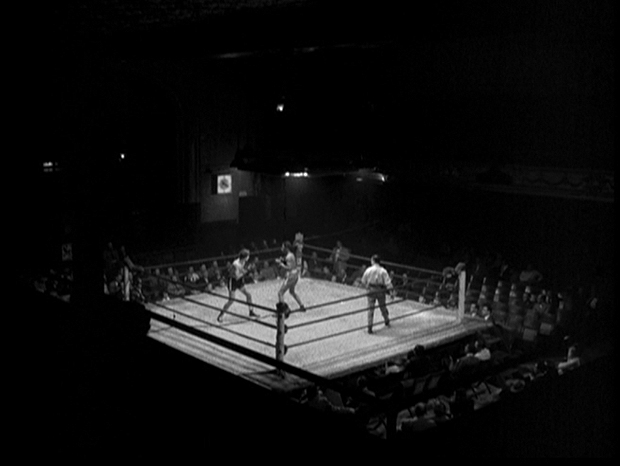
48 MLS Davey with his manager, having his wrists taped. (8:12)
There is no music. Instead, we hear the roar of the crowd. When we move to the street scenes, city sounds will be the music.
49 MCU Davey from the front and below, his left wrist and hand being taped. (8:15)
Shot 48 | Shot 49 |
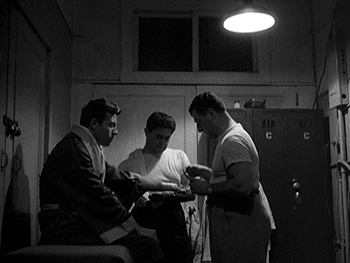 |  |
50 LS Busy New York street. (8:33)
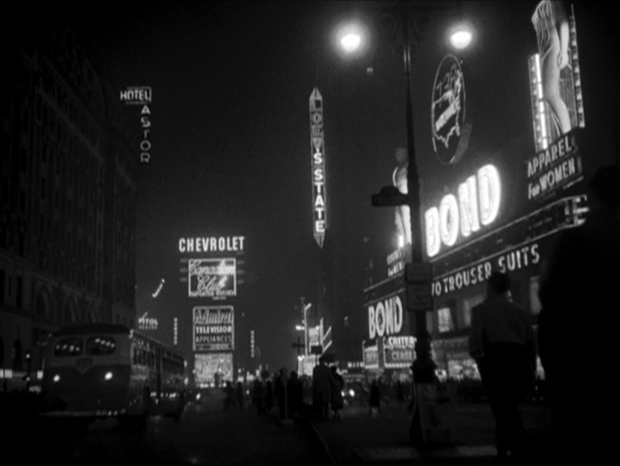
51 MCU of an automated Santa doll in a shop window with candied apples and Milk Chocolate Brazils. (8:37)
52 MS of sausages and buns. (8:41)
53 MS Plastic sundaes on a revolving pedestal with a pineapple in the background. (8:44)
54 Photos through a neon Photos sign. (8:46)
Reflected in the window is a sign from across the street with lights flashing on and off in a circular pattern.
55 A toy doll in a bowl of water swims in circles. (8:48)
56 A sign advertising dancing hostesses at a dance hall. (8:53)
We begin to hear music from inside the club. It's Gloria's theme but jazzier. Once in the dance hall, the music will be loud and the piece to which the couples are dancing.
57 A sign advertising dancing partners. (8:56)
58 Another such sign. (8:58)
Shot 51 | Shot 52 |
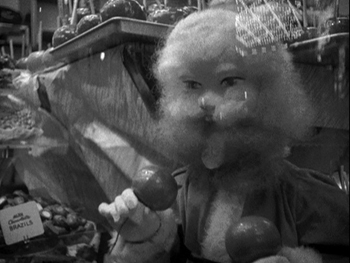 |  |
Shot 53 | Shot 54 |
 | 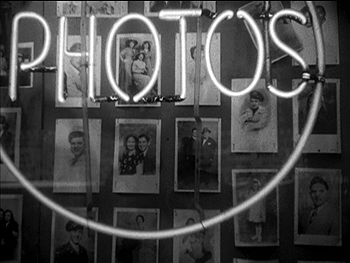 |
Shot 55 | Shot 56 |
 |  |
Shot 57 | Shot 58 |
 |  |
59 MS Man in ticket booth. (9:00)
60 Vinyl spinning on platter. (9:03)
61 Dancers inside the dance hall. (9:05)
62 A dressing table with cup, shoes, hair brush, snips, and various beauty tools and cosmetics. (9:47)
Shot 59 | Shot 60 |
 |  |
Shot 61 | Shot 62 |
 |  |
63 MS of Gloria slipping off her top, reflected in a mirror. (9:49)
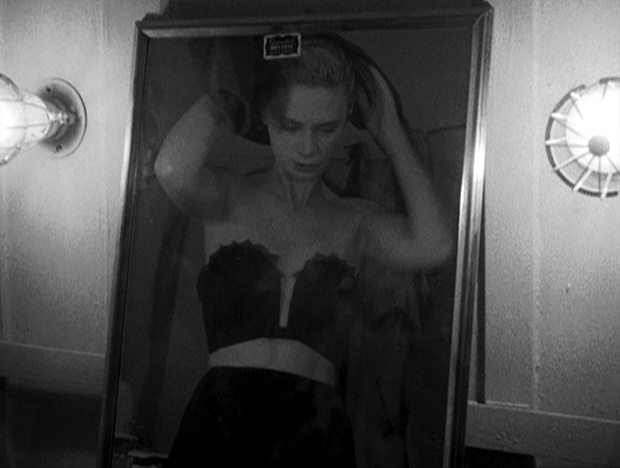
64 MCU Davey's head being rubbed down by his trainer, from rear of Davey. (9:59)
There is no music throughout the boxer portion.
65 MCU Davey's head being rubbed down by his trainer, priofile. Then his neck and chest. (10:04)
66 MCU Davey's manager looking on. (10:14)
67 MCU Davey now in left profile, his manager again rubbing down his chest, shoulders, arms, back and face. (10:14)
68 LS The ring with one man down on the ropes. He rises before the countdown ends. (10:35)
69 MS Davey warming up with his manager, from Davey's left. (10:44)
70 MS Davey warming up with his manager, from Davey's right. (10:48)
Crossfade to Vincent's office, Davey seeming to give him an uppercut.
Shot 64 | Shot 65 |
 |  |
Shot 66 | Shot 67 |
 | 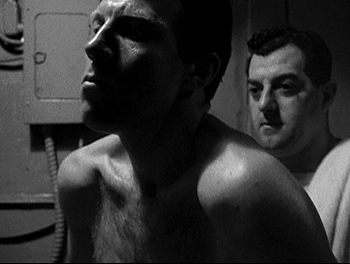 |
Shot 68 | Shot 69 |
 |  |
Shot 70 | Shot 70a |
 |  |
71 MS Vincent in his office. The crossfade ends about 10:54. (10:54)

He has advanced to look out his window, drinking. Turning from the window as he finishes his drink, he cuts off the light in his room which puts the focus on the television which he turns up.
SPORTS ANNOUNCER (voice-over): ...brings together two very game boys. The youngster, undefeated in twenty-two professional encounters, Kid Rodriguez, and the veteran, Davey Gordon, who's emerged victorious in (covered by voice announcing Davey Gordon's entrance into the ring) while losing 9 and drawing 2.
72 MS of the television showing the boxing event. (11:22)
SPORTS ANNOUNCER (voice-over): Gordon's long career, he's now 29, has been one long promise without fulfillment, at least thus far. As hard a puncher as they come, a clever boxer, he's been plagued by a weak chin...
73 MS of Vincent. (11:35)
SPORTS ANNOUNCER (voice-over): ...and the unlucky knack of being at his worst for the big one. And tonight is a big one...
74 MS of the television showing the boxing event. (11:38)
SPORTS ANNOUNCER (voice-over): ...with a title...in the offing for the winner. And now let's take time out for a friendly word from our sponsor.
75 MS of Vincent. (11:46)
SPORTS ANNOUNCER (voice-over): How many times have you come home in the evening and wanted to feel the love...
Getting an idea, Vincent puts down his drink and starts for the door.
Shot 72 | Shot 73 |
 |  |
Shot 74 | Shot 75 |
 |  |
76 MS of dance floor. (11:49)

Vincent finds Gloria on the dance floor with a soldier. He interrupts (in order to take her back up to the office to watch the fight) and the soldier objects, they begin pushing each other.
77 MLS Two of Vincent's bouncers notice the fight. (12:06)
78 MS Gloria draws away. (12:08)
79 MLS Vincent's bouncers decide to get involved. (12:10)
80 MLS Vincent and the soldier arguing. (12:12)
Vincent pushes the soldier away and the two bouncers grab him and begin to drag him out.
81 LS The referee in the ring. (12:17)
He calls the two boxers in.
82 MLS Vincent hurriedly escorting Gloria off the dance floor. (12:23)
Shot 77 | Shot 78 |
 |  |
Shot 79 | Shot 80 |
 |  |
Shot 81 | Shot 82 |
 |  |
83 MS of the television showing the boxing event. (12:32)
We hear the door open and close as Vincent and Gloria enter off-screen.
We see the shape of the television screen is as the fishbowl in which we observed Davey's face in shot 15.
84 MLS The office. (12:37)
Vincent guides Gloria in by the elbow.
85 MS Davey's mouthguard being put in. (12:41)
86 LS of Kid Rodriguez from across the ring, shot through Davey's legs. (12:45)
He rises. The bell rings and the two men begin the fight.
87 MS of Kid and Davey. (13:00)
They circle around and around, delivering punches.
88 MCU Of Kid and Davey. (13:14)
Davey gets it on the jaw.
89 MCU Of Kid and Davey. (13:15)
This time Kid gets it.
90 MCU Davey getting socked in the right ear. (13:15)
91 MS Another punch sends Davey down. (13:16)
The referee begins the count down. Davey struggles to stand and manages to do so at the count of 8.
92 As the referee takes Davey's hand and leads him back into the ring, cut to MLS of Vincent hugging Gloria closely as they watch the fight. (13:30)
Shot 83 | Shot 84 |
 |  |
Shot 85 | Shot 86 |
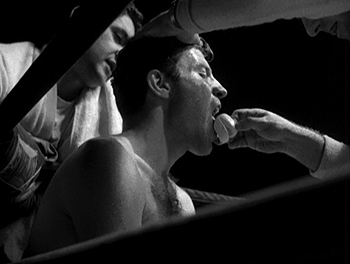 |  |
Shot 87 | Shot 88 |
 |  |
Shot 89 | Shot 90 |
 |  |
Shot 91 | Shot 92 |
 |  |
93 MS of Davey and Kid. (13:32)
Davey rallies then grabs Kid and pushes him back against the ropes.
94 MS of Davey and Kid. (13:37)
Davey and Kid are still grappling. The referee separates them. Kid lands a good punch on him.
95 MLS of Kid and Davey. (13:45)
Kid lands punches on Davey time and time again.
96 MLS of Davey falling into the ropes from behind. (13:48)
He falls outside the ropes.
97 MLS The referee pulls Davey back into the ring. (13:53)
He and Kid go at it again.
98 MS Davey and Kid. (13:57)
Kid launches into Davey good.
99 MLS Davey and Kid. (14:04)
They circle and punch.
100 MCU Davey and Kid. (14:12)
The camera is in tight enough so that we see only arms swinging then Kid landing a punch on Davey.
101 MS Kid and Davey. (14:13)
The camera is in tight enough so that we see only arms swinging then Kid landing a punch on Davey.
102 MS Kid and Davey. (14:13)
Cut from 101 to 102 clips out some action so that suddenly Davey and Kid are reversed with the referee in the same position behind them. They circle a couple of times more then Kid presses Davey against the ropes and rains punches on him.
103 MS from below of Davey and Kid. (14:27)
104 MS Davey from behind. (14:30)
They circle. He throws a punch and misses Kid. Kid strikes Davey.
105 MLS Kid from behind. (14:34)
Kid misses Davey and pursues him.
106 MS Davey. (14:38)
107 MS Kid and Davey. (14:42)
108 MS Davey from below. (14:44)
109 CU Davey from below. (14:46)
110 MCU Kid from the right. (14:47)
111 CU Davey. (14:48)
112 CU Kid being hit. (14:49)
He dodges back and comes in to strike.
113 MS Davey from behind Kid's boxing gloves. (14:52)
114 MCU Kid. (14:52)
Shot 93 | Shot 94 |
 |  |
Shot 95 | Shot 96 |
 | 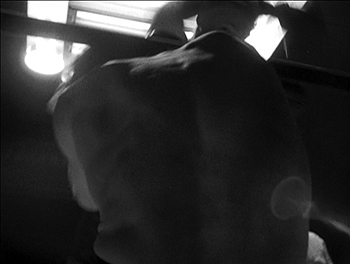 |
Shot 97 | Shot 98 |
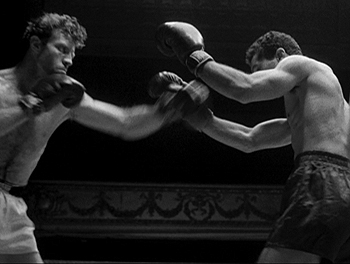 | 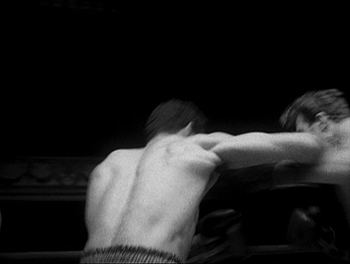 |
Shot 99 | Shot 100 |
 |  |
Shot 101 | Shot 102 |
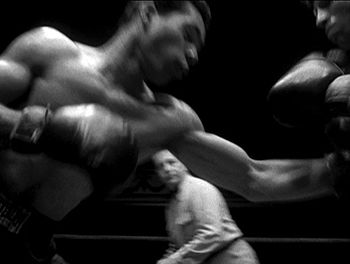 |  |
Shot 103 | Shot 104 |
 |  |
Shot 105 | Shot 106 |
 | 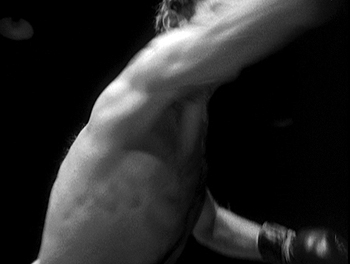 |
Shot 107 | Shot 108 |
 |  |
Shot 109 | Shot 110 |
 |  |
Shot 111 | Shot 112 |
 | 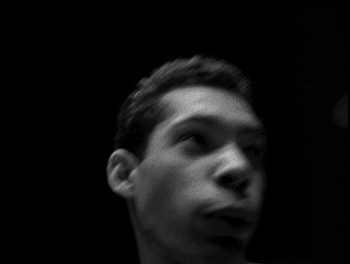 |
Shot 113 | Shot 114 |
 |  |
As far as trying to get an accurate shot count, this is the first shot that's been trouble, as the glove almost fully eclipses the camera lens, then it does seem we have one shot as the camera chaotically tilts up, simulating Davey going down, the light above jumping around before it stabalizes on the referee counting down.
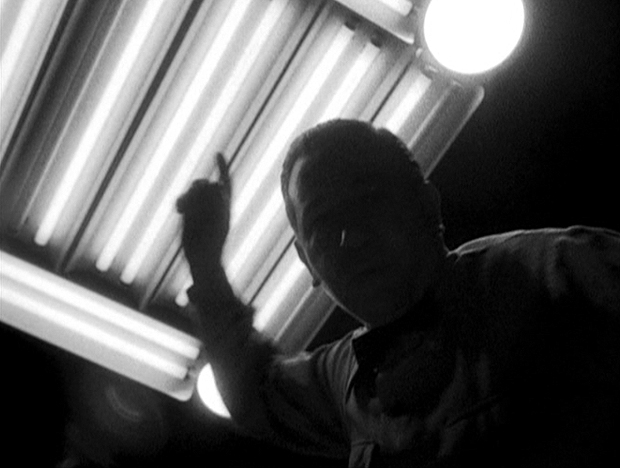
REFEREE: One, two...
115 CU Davey struggling to stand. (14:58)
REFEREE: ...three, four...
116 CU Davey Davey from below, having stood. (15:00)
REFEREE: ...five, six...
117 Davey's POV of Kid across the ring. (15:02)
REFEREE: ...seven, eight...
118 MCU Davey rising fully to his feet. (15:04)
119 MLS Davey on his feet. He and Kid face each other again. (15:07)
120 MS Kid launches into Davey. (15:09)
121 MS Gloria and Vincent in his office, watching the fight. (15:13)
122 MLS Davey and Kid. (15:14)
123 CU Davey, he gets hit again in the chin. They grapple. (15:24)
124 MCU Kid. (15:27)
125 MLS Davey wings and misses and is hit by Kid. (15:28)
126 MCU Kid. (15:30)
127 MCU Davey. The moment of defeat. (15:32)
128 MLS Davey goes down. (15:33)
129 MLS Davey's down. The bell rings. His manager and trainer come out and pull him up. (15:35)
130 MLS Davey is seated in his corner. Revived, he leaves the ring. (15:55)
HECKLER: ...go on home...you're a flop...you're all through...
131 Vincent and Gloria grappling. (16:22)
ANNOUNCER: Tonight, we may very well have seen ring history in the making in the form of the sensational, young, welterweight Rodriguez and his impressive KO over the experienced campaigner Gordon. But, for Gordon, tonight must come as a bitter pill indeed. This was the fight for him to prove his glass chin had been made into sterner stuff, but, unfortunately for him, tonight, again, it was as fragile as ever. It's a well known ring adage that too much education...
Fade out.
Shot 115 | Shot 116 |
 |  |
Shot 117 | Shot 118 |
 |  |
Shot 119 | Shot 120 |
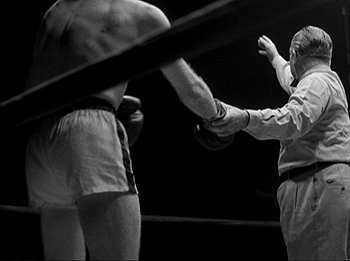 | 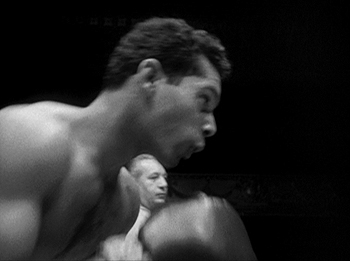 |
Shot 121 | Shot 122 |
 |  |
Shot 123 | Shot 124 |
 | 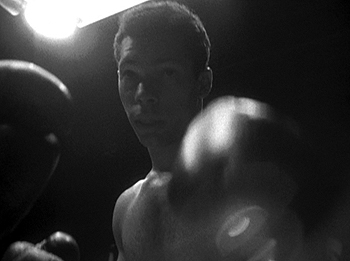 |
Shot 125 | Shot 126 |
 |  |
Shot 127 | Shot 128 |
 | 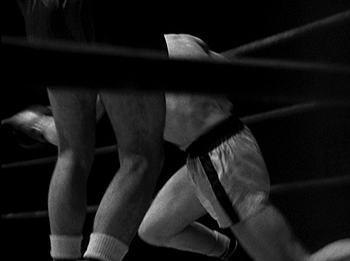 |
Shot 129 | Shot 130 |
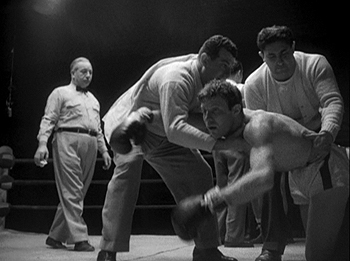 |  |
131 Vincent holding Gloria. (16:22)
Her attention is torn between Vincent and the fight. Then she seemingly willingly kisses Vincent.
Another musical theme has entered, one which I'll call Vincent's.
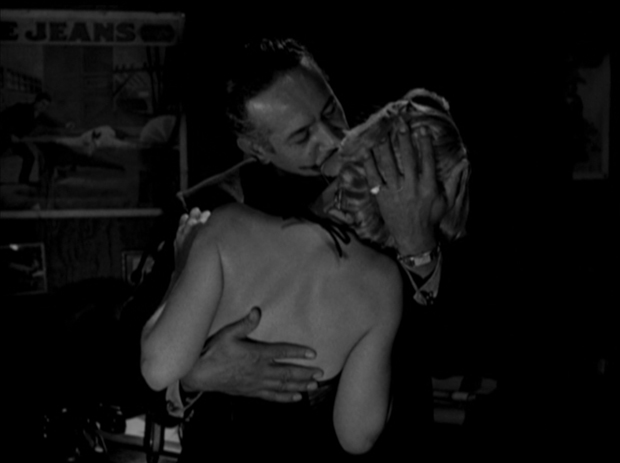
ANNOUNCER: Tonight, we may very well have seen ring history in the making in the form of the sensational, young, welterweight Rodriguez and his impressive KO over the experienced campaigner Gordon. But, for Gordon, tonight must come as a bitter pill indeed. This was the fight for him to prove his glass chin had been made into sterner stuff, but, unfortunately for him, tonight, again, it was as fragile as ever. It's a well known ring adage that too much education...
Fade out.
Just as with the goldfish bowl, the shots prior the boxing bout that Kubrick likely expected to stand out and be conversation pieces were the Santa and the swimming baby. And they do stand out even after all these years. Those three shots--the goldfish bowl, the Santa and the swimming baby--are the WTH shots that yank this movie out of film noire crime genre and place it on a shelf all its own. They're strategic but as far as I can tell they have little to do, as people purport, with Kubrick's training as a photographer and his appreciation for the peculiarities over which most eyes pass. If you examine his work as a photographer, at least that which was published, images such as these are not to be found. Though he occasionally pictured what the majority might identify as quirk, his photography was largely people oriented, just as in his later films his shots are almost always concerned with leading characters.
It's shots of this type, isolating and focusing on details apart from characters, that Kubrick eliminated in his later films. One imagines that he was wanting to give a personal taste of the life of Times Square, principally food and toys. The little doll swimming around in the bowl may remind us of the goldfish trapped in its bowl at Davey's.
The Festival of Lights finds its way into a number of Kubrick's films. Though it's October, we have a Santa in a shop window. In The Killing it is also September/October but one shot deliberately shows Christmas decorations up and down the street, though in the 1950s these decorations would not have been on display until Thanksgiving. The timeline of events in The Shining places final events happening around the time of the holiday season. Eyes Wide Shut occurs during the holiday season.
In Day of the Fight, Kubrick related, seemingly, chess to the fight through the number 64. I have written in my analysis on that movie:
Excepting the 4 title card shots in the Kubrick production of the film, there are 101 shots. My rationale behind leaving out the 4 title card shots is this. At shot 30 in the Kubrick production of the film, the voice-over notes that it's 4 o'clock and Walter has 6 hours until he enters the ring. It is with shot 64 that Walter is shown ring-side. So, first it is said that at 4 Walter has 6 hours until his fight, then we have Walter approach the ring in shot 64.
Also, shot 6 is at 6 a.m.
Now, what happens to this with the appended introduction of the Bonafield production? Of course, it is thrown off. Walter no longer appears ring-side in shot 64. How is Kubrick to preserve the association of the number 64 and the boxing ring? How about in the appended introduction? What if he transfers the number 64 to that, which it seems is the idea he came up with, for the number of shots in that introduction are 64. Whereas shot 64 had been, in Kubrick's production, associated with the boxing ring and the boxers approaching it, we instead are delivered over to the original body of Kubrick's film.
What is occurring in shot 64 in this film? Kubrick cuts away from Gloria, at the Pleasure Land, preparing to go out on the dance floor, and in shot 64 shows Davey continuing to prepare for his fight in the boxing ring. Though we are first shown the boxing ring in shot 47, then Davey being prepared in shot 48, I believe that Kubrick is referring back to to the use of 64 in Day of the Fight and noting its intentionality. In this film, at shot 128, Davey falls to the mat for the final count. That is 64 shots from shot 64.
Kubrick's first feature film, Fear and Desire, by inference incorporated chess by it being based on Shakespeare's The Tempest, the only play of Shakespeare's in which a chess game is shown being played on stage.
Victor's party in Eyes Wide Shut, though top tier, has always strongly reminded me of the Pleasure Land dance hall of Killer's Kiss.
In section two of the analysis, after Iris' dance, I write a little of the culture of taxi dancers. This dance hall was based on a real one, what was once The Parisian in New York, and shots of the advertisements of the hostesses were taken outside the establishment, but I'm unclear if the dance floor was filmed at the Parisian or elsewhere. I have read that Vincent's office was filmed at the apartment of a friend.
I don't know about all of them, but several of the posters on Vincent's wall are from old theatrical productions, two being from melodramas by Joseph Arthur.
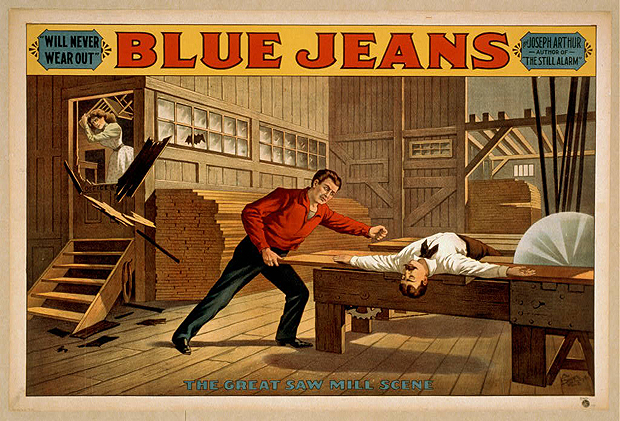
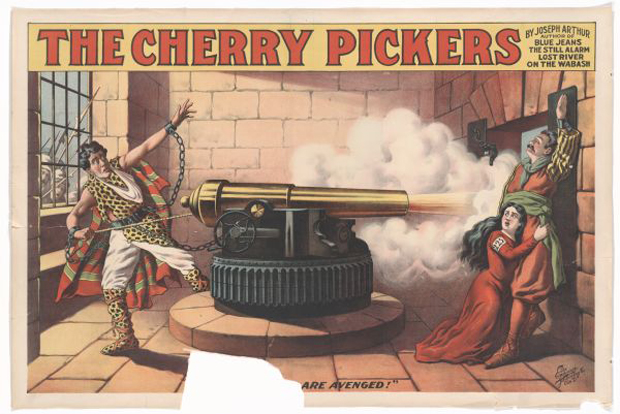
The below is from Wikipedia on the plot of the play "Blue Jeans".
Perry Bascom returns home to Rising Sun, Indiana to make a run for Congress, and marry Sue Eudaly. Sue's ex, Ben Boone, is nonplussed at this turn of events, and successfully runs for office against Bascom. Bascom later sours on Sue, and divorces her to marry June. After various twists, Boone corners June and Bascom at Bascom's sawmill. After knocking Bascom out, Boone places him on a board approaching a huge buzz saw. June, locked in an office, escapes just in time to save Bascom from certain death.
This is a review of The Cherry Pickers.
"THE CHERRY PICKERS"
Military Melodrama with Qorgeous East Indian Trappings
The patrons of Morosco's Burbank theater are again furnished with a bill of fare that pleases their taste, In the staging of Joseph Arthur's four-act military melodrama entitled "The Cherry Pickers." The scene Is laid In upper India during the Afghan- English war of 1878-79, a fact which Is only important in that it enables the dramatist to Impart some gorgeous oriental coloring to the theatrical display. A number of the gentlemen and some of the ladles have to Impart a coffee-hued tinge to their complexions and even the leading man la obliged to assume the appearance of a young Othello. As for the story, it is the familiar one of love and jealousy, with a very deep-dyed villain thrown In, and enlivened by some comic scenes, the dialogue of which Is more amusing than usual. Mr. Spencer as the half-caste soldier In the British army who insults his superior officer—the villain — and who gets sentenced to be shot in consequence, goes through a variety of thrilling adventures, not the least exciting of which is his escape from being blown to pieces by a huge revolving cannon mounted in the center of the stage. He is luckily saved by the heroine in the nick of time, and though the cannon Is discharged with much noise and smoke the dusky hero is unhurt and is united in the end to the fascinating Miss Kenible, who goes prettily through many troubles and persecutions for his sake. Mr. Oberle Is In his element as the bad man of the play and never fails to emphasize the objectionable features of the character he assumes. He succeeded so well in this last night that he was honored by being soundly hissed on the recall of the characters at the fall of the curtain. Frank MaeVlcars had a character bit as the Afghan spy which was made up and played with his customary skill and thorough attention to detail. Phosa McAllister in the comedy character of an Irish widow received perhaps the largest share of attention and applause, which was well deserved, her rich brogue and racy style being Inimitable. Elsie Esmond, who has had too little to do during this engagement, played an ingenue part with much grace and vivacity. Miss Esmond is a clever little actress with a face that reminds one of Maud Adams and with an Interpretative ability that is all her own. There is a large cast of characters in "The Cherry Pickers," which title, by the way, Is supposed to be taken from the cognomen of a regiment In her majesty's service. The support is good and the efforts of the soldiers to struggle with the dialect peculiar to the British Tommy Atkins deserve much praise, even though in some instances the dialect is a misfit almost as bad as Lieutenant York's scarlet trousers. The play has not been given here before, and it seems likely to duplicate the success It made In the east. O. A. D.
Arthur was a hack who was able to produce what the audience wanted and do so spectacularly. What the audience liked was their men fighting over a woman and big-time weaponry threatening the hero. On stage. Live. It had to look like the hero might really be endangered by the saw and the cannon. There had to be that illusory element of risk, then tense withheld breath relieved by the good guys planting a perfect landing on the righteous balance side of justice for a 10 point score and rousing applause.
Film made the threat of danger even more realistic to the audience, but removed the thrill aspect of the circus tightrope walker entertaining without a safety net.
The posters have in them plot elements we find in Killer's Kiss, a woman who is wanted by two men, and a dramatic fight scene deciding the victor.
Posters of this type were on the kitchen wall of Rosemary Williams, the showgirl Kubrick photographed for a story in LOOK which never ran, and who can be looked upon as the feminine version of Walter Cartier. The posters on her kitchen wall advertised a theatrical in which a girl leaves her abusive home feeling deep in her bones that she is from a higher class and destined for better things. The play eventually reveals that she is the daughter of an upper class couple, and that shortly after birth she was accidentally switched with the daughter of the lower class couple. The heroine, who is everything good, is reunited with her wealthy birth parents. The anti-heroine, whose nature reflects her low birth, is reunited with her true parents. I have wondered if Kubrick himself chose those posters for Rosemary's kitchen.
In this film, a comparison is being made between the dance hall and the arena, Gloria's preparations with Davey's, both rings occupied by sparring couples.
The fight is an amazing simulation. There is nothing about it which doesn't communicate as brutally real, and I used to believe that the film was not much more than a vehicle for it. I no longer think this, but the fight is Kubrick's declaration of independence from the still camera and his telegraph to the motion picture industry of what he's able to do and that he's there to stay.
Many of the shots of Davey preparing for his fight were already tested out in Kubrick's first film, Day of the Fight, but in that situation it was Walter Cartier's brother helping to prep him for his fight. In that film we had Walter's hands being wrapped, him being oiled, and Walter sparring with Vincent.
What's missing from the simulation of the fight is the audience. We see them in the televised shots. We hear them. But never, during the fight of Kid and Davey, do we have shots of the audience. They fight in a black box. The souls in the movie theater and Gloria and Vincent serve as audience. We get our cue from Gloria anf Vincent of the effect of the fight on the observers, which is a mixture of curiosity, of horror, of excitement, and finally an erotic charge. At least so it seems for Vincent and Gloria. I wouldn't personally know. I don't like boxing. I don't like football. I don't find head injuries sexually exciting. But Vincent, who had earlier seen Gloria with Davey, appears to be excited by the fight and displaying Davey's defeat to her. Gloria, too, is presented as being captivated by the boxing version of a train wreck. It's to be remembered she's watching a neighbor who she only that day learned was a boxer, she's observing his defeat.
It's with this television advertisement that Vincent remembers to run down and get Gloria to watch the fight with him. The signal is sent out that Vincent, despite his cruelties, perhaps thinks of himself as being in love with Gloria. Or rather, he's lonely and wants a hookup.
This is one of the more peculiar signals to us broadcast by the announcer, that Davey is not doing as well in the ring as he might because of a cultivation of brain getting in the way of brawn, at least as represented by Kubrick and the scriptwriter. We're given no other background on this and there is nothing in Davey's apartment that alludes to Davey's education and what it might concern.
The heart of this section is the fight, and the heart of the fight turns out to be shot 114. Which is rather astonishing that we have 114 seemingly even before Dr. Strangelove, and before Lolita in which we find also a variation on 114 that is directly linked to Dr. Strangelove, the script for which had been in the works while filming for Lolita was being done.
Much is made of Kubrick's use of CRM-114, from Dr. Strangelove, in other films, and I've written a good deal in other analyses on my belief on Kubrick's use of this. What I was not expecting was 114 iin a film before Dr. Strangelove, as CRM-114 was first used in Red Alert, the 1958 book upon which Dr. Strangelove is based. But here we have shot 114 as the one where Davey is essentially defeated. He's actually done for before he's even entered the ring, but shot 114 is the one where the theater audience and the camera have Davey's point of view as Kid's glove strikes, obscures the lens, the screen goes chaotic with our having the POV of Davey falling flat on his back, his eyes focusing on the light and the referee as he counts all the way to eight. Davey manages to get back up on his feet, but it takes five shots for him to do so. For all intents and purposes the fight is over.
If one is imagining this 114 is coincidence, it appears not to be, as this shot is referred back to later in the film and is connected with the number 11-4. In the warehouse to where Gloria is taken when kidnaped, the Ace of Spades, which can be an 11 or a 1, and 4 of Spades are specifically used between the two gangsters to signal intent to take out Davey, and when the signal is given those cards are thrown at Davey, disorienting him, leading to him being KO'd b y 11 and 4, just as here he is KO'd at shot 114. Kubrick several times shows us the ace of spades together with the four of spades, so he really wants us to pay attention to the combinaton, and certainly links their meaning back to shot 114. But as to whether 11-4/114 has the same meaning in this film as in his later works isn't clear. I discuss this a little more at the end of section four. I really didn't want to get preoccupied with the 114 at this point in the analysis--nor in this film. I'd really prefer if 114 didn't make an appearance in this film.
To read more about how Kubrick does indeed count shots and sometimes signals this, see A Brief Primer on Stanley Kubrick's Counting Shots in his Films. I give several good and explicit examples, one very easy to describe one being from this film, and another being from his first film Day of the Fight which I've previously touched on in this analysis.
Up until Davey's loss in the ring, we have, after a fashion, a replay of Kubrick's first short, Day of the Fight, about Walter Cartier preparing for a successful bout in the ring, but it is a dark replay and Davey loses..
Kubrick had first photographed Walter Cartier for LOOK, and Incorporated into Killer's Kiss is a version of what would have been his female counterpart, had the pictorial Kubrick shot on Rosemary Williams ran, who had been in 1949 an up-and-coming showgirl. Their bright futures and the realization of their ambitions were framed by Kubrick's portrayal of hard work, dedication, personability, and spiritual inclinations such as depicted with their attending church. I have read remarks of others on how Walter was a nice guy. Rosemary, however, was on her way to some trouble and not in a way that made others empathetic with her situation. Up until 1951 Cartier's career wasn't all wins, but it was nearly all wins and solid. Then came the Kid Gavilan fight in December of 1951, after 20 straight Cartier wins from March of 1949 to November of 1951, and seven months after the release of Day of the Fight in April of 1951. From what I've read, Kid Gavilan was pretty well the end of Cartier's career. Rosemary's showgirl/actress dreams were also dust by 1952.
Both characters in Killer's Kiss are failures (though Gloria never had ambitions of being a dancer, she was playing out the loss of self of her ballerina sister, we will learn). In Day of the Fight, Cartier had his brother and aunt on hand and depicted as supportive of him, while the only relations we ever learn of Davey having are an aunt and uncle who are supportive but live on the opposite coast out in Washington state. Davey and Gloria are lonely souls in New York in depressing circumstances. Day of the Fight ended with Walter briefly celebrating his victory in a fight. Davey loses his fight with Kid Rodriguez (note how this has an echo in it of Walter losing to Kid Gavilan). The story of Killer's Kiss progresses beyond Day of the Fight's biopic on a successful boxer and becomes instead a film of what happens with these two individuals who have reached their bottom.
August 2014 transferred to html. Approx 13,420 words or 27 single-spaced pages. A 103 minute read at 130 wpm.
Go to Part 2
Go to Table of Contents of the analysis (with supplemental posts)
Link to the main TOC page for all the analyses